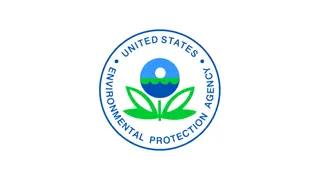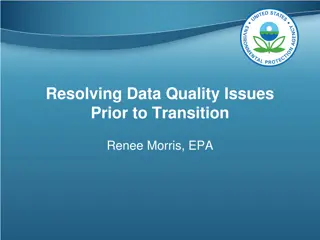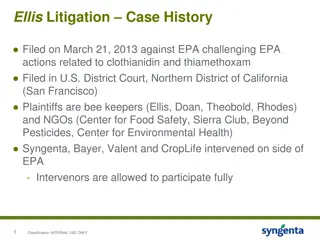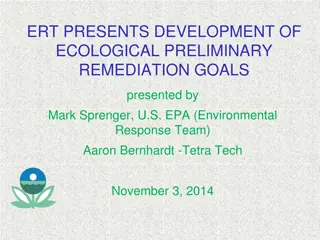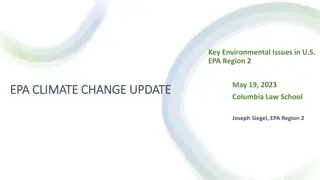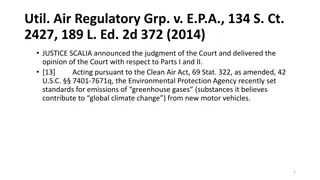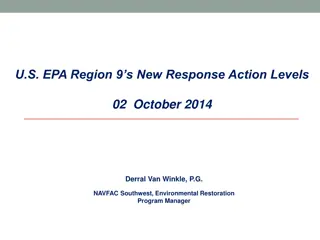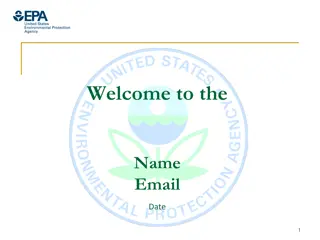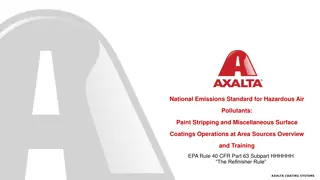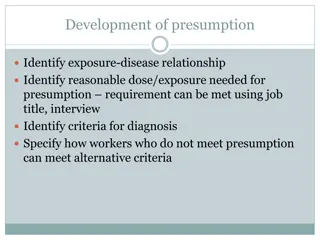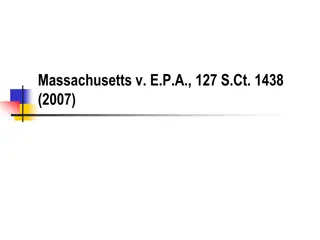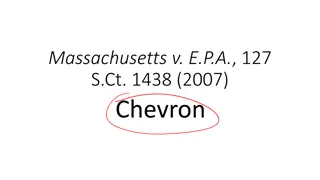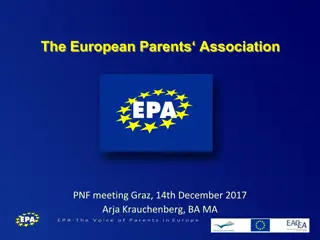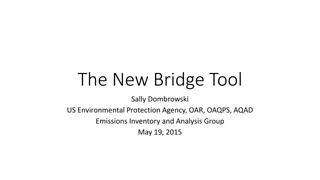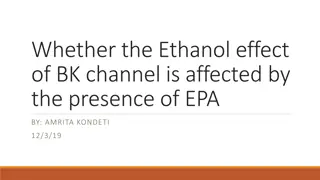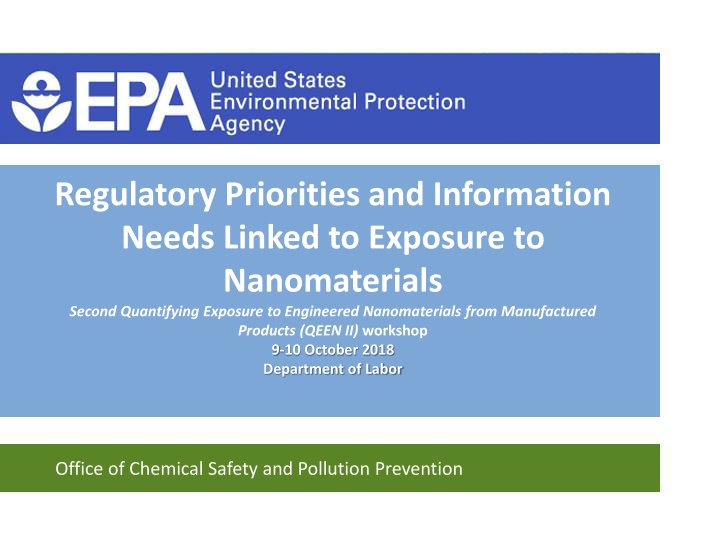
TSCA Regulations for Nanomaterials Exposure Management
This content discusses the Toxic Substances Control Act (TSCA) and its role in regulating nanomaterials exposure in the U.S. It covers the requirements for submitting information on new chemicals, considerations in new chemical reviews, and the management of nanoscale materials under TSCA. The overview also emphasizes the importance of evaluating and controlling unreasonable risks associated with chemicals for human health and the environment.
Download Presentation

Please find below an Image/Link to download the presentation.
The content on the website is provided AS IS for your information and personal use only. It may not be sold, licensed, or shared on other websites without obtaining consent from the author. If you encounter any issues during the download, it is possible that the publisher has removed the file from their server.
You are allowed to download the files provided on this website for personal or commercial use, subject to the condition that they are used lawfully. All files are the property of their respective owners.
The content on the website is provided AS IS for your information and personal use only. It may not be sold, licensed, or shared on other websites without obtaining consent from the author.
E N D
Presentation Transcript
Regulatory Priorities and Information Needs Linked to Exposure to Nanomaterials Second Quantifying Exposure to Engineered Nanomaterials from Manufactured Products (QEEN II) workshop 9-10 October 2018 Department of Labor Office of Chemical Safety and Pollution Prevention
Overview Background on TSCA New Chemicals Review Considerations New Chemical Categories Regulatory Determinations under TSCA Issues with Developing a Nanomaterials Category 1 Office of Chemical Safety and Pollution Prevention
Toxic Substances Control Act (TSCA) - An Overview Provides basic authority for chemicals regulation in the U.S. TSCA requires EPA to: Evaluate and, where appropriate, control unreasonable risk for new chemicals and new uses of certain existing chemicals Prioritize, evaluate and address risk for existing chemicals that present unreasonable risk to health or the environment Gather information on new and existing chemical substances and mixtures, including requiring testing where needed to fill data gaps Coordinate with other Federal agencies Nanoscale materials are managed under TSCA; No U.S. legislation specific to nanoscale materials 2 Office of Chemical Safety and Pollution Prevention
TSCA Information Required to be Submitted for New Chemicals via Premanufacture Notices (PMNs) Chemical Identity Includes particle size and particle size range Morphology or shape Byproducts and impurities Estimated production/import volume Proposed uses and amounts for each use Human exposure information Disposal methods and estimates of releases to the environment Existing test data in submitter s possession or control concerning human and environmental effects 3 Office of Chemical Safety and Pollution Prevention
TSCA New Chemical Review Considerations Releases to air and water, disposal Environmental exposure Worker exposure Assessment of production, processing (formulation), and uses General population exposure PMN Submission and identified conditions of use Consumer exposure Characterization 4 Office of Chemical Safety and Pollution Prevention
Review of New Chemicals EPA reviews ~1000 new chemical submissions annually Statutory review period is short 90 days Very few submissions include data (<15%) Reviews are typically based on structural analogues and categories 5 Office of Chemical Safety and Pollution Prevention
New Chemical Categories Chemical Categories are a practical way to extrapolate existing data to analyze related substances Category evaluation supports: Greater weight of evidence Increased confidence in conclusions Better basis for establishing biological plausibility Category analysis facilitates strategic testing to fill data gaps, where necessary Weight of evidence used for deciding on additional testing Defines the nature and scope of any potential testing needs 6 Office of Chemical Safety and Pollution Prevention
Categorization of Nanomaterials No category currently exists for nanomaterials specifically U.S. focus is on toxicity of components For example, Cd Functionalization of coatings Persistence in the environment Nanomaterials may also fit into existing chemical categories, such as Respirable, poorly-soluble particulates : Category is based on data for five different poorly-soluble particulates: silica, talc, titanium dioxide, a lithium manganese oxide, and carbon black Use U.S. NIOSH REL for CNT/CNF (1 ug/m3) for risk assessment Physico-chemical properties testing and a 90-day inhalation toxicity test (OECD TG 413+ BAL) are often necessary to evaluate potential health and environmental impacts of nano substances 7 Office of Chemical Safety and Pollution Prevention
TSCA Determinations Under Section 5 Insufficient Information and May Present An Unreasonable Risk Chemical Substance Produced In Substantial Quantities Insufficient Information to Make A Reasoned Evaluation Not Likely To Present An Unreasonable Risk Presents An Unreasonable Risk 8 Office of Chemical Safety and Pollution Prevention
Section 5 Review and Determination Insufficient Info and May Present An Unreasonable Risk As a result of the review, EPA determines that, in the absence of sufficient information to conduct a reasoned evaluation, the manufacture, processing, distribution in commerce, or use, may present an unreasonable risk of injury to health or the environment under the conditions of use. Regulation under section 5(e): Regulation Pending the Development of Information Section 5(e) order Testing or other potentially useful information may be required 9 Office of Chemical Safety and Pollution Prevention
Disposition Engineering controls PPE (gloves, respirator APF 50) or Exposure Limit Disposition No new use prior to notification Very limited to no release to the environment Limits on types of consumer uses Testing 10 Office of Chemical Safety and Pollution Prevention
Testing P-Chem Tests Testing 90-day inhalation study OECD TG 413+BAL and other Pharmacokinetics Modified Ecotoxicity Testing 11 Office of Chemical Safety and Pollution Prevention
Nanomaterials under the TSCA New Chemicals Program More than 210 new chemical notices for nanomaterials have been received since 2005 Most notices have completed EPA review, are regulated, but allowed in commerce Requirements to prevent human and environmental exposure (PPE, certain end uses not allowed, no release to water, etc.) Requirements to develop data for fate, ecotoxicity, and/or toxicity A limited number of 5-day, 28-day, 90-day, acute, irritation, sensitization, intratracheal instillation, and genetic toxicity studies have been conducted on nanomaterials (many of which have been on CNTs) 12 Office of Chemical Safety and Pollution Prevention
Carbon Nanotubes/Fibers EPA has received new chemical notices under TSCA on over 100 carbon nanotubes and fibers Each CNT is considered a distinct chemical substance. Some key parameters: # walls inner diameter, outer diameter and length functionalization capped or open ended straight, branched, or tree structure Production volumes have ranged from less than 100 kg scale to greater than 100,000 kg 13 Office of Chemical Safety and Pollution Prevention
Challenges to Development of Chemical Category for CNTs Nanomaterials (and specifically CNTs) are engineered to have particular properties, which is different than functional group-based chemicals (aldehydes, ethers, etc.) How do chemical-structural and material characterization properties correlate with physical-chemical properties? CNTs often do not exist as distinct species; rather the populations of the materials can consist of distinct species and agglomerates and aggregates A broad range of potential CNT forms may affect toxicology Insufficient data to identify relevant properties or identify properties key to establishment of a CNT category Unclear test methods/relevance of results 14 Office of Chemical Safety and Pollution Prevention
Variables in the Building of a Specific MWCNT Category Coated, Derivitized In vitro results Short term in vivo verification TiO2 Uncoated, Underivitized Interpolation of New MWCNT NOAELs MWCNTs Cytotoxicity Inflammation Pulmonary Fibrosis Distal Organ Effects Other Compare to Known Subchronic NOAELs Metals Aspect Ratio Surface Area Prioritize several MWCNTs for Targeted Subchronic Testing Office of Chemical Safety and Pollution Prevention
Environmental Fate of CNTs The Agency has insufficient information regarding the fate and transport of CNTs, and makes the following protective assumptions when assessing CNTs 0% removal by a Publicly Owned Treatment Works (POTW) or a Waste Water Treatment (WWT) Plant from either biodegradation or sorption for assessing releases to surface waters 0% removal via incineration Rapid migration to groundwater from landfills High persistence in the environment Rapid transformation to highly dispersible chemical species via reaction with sunlight and natural organic matter 16 Office of Chemical Safety and Pollution Prevention
Ecotoxicology The Agency has not adopted a concentration of concern for CNTs CNT toxicity generally reported in the 10s to 100s ppm for both water- and sediment-borne material Sublethal effects have been noted in rainbow trout at levels as low as 100 ppb. The solubility of CNTs is predicted < 1 ppb, but stable dispersions may be created in the presence of natural organic matter or via functionalization (environmentally feasible) Uptake studies in whole aquatic organisms indicate that CNT uptake is limited to ingested material CNT functionalization, length, capping, and purity may affect ecotoxicology 17 Office of Chemical Safety and Pollution Prevention
Environmental Risk Assessment Development of nanomaterial-specific test guidelines are needed for more appropriate environmental hazard assessment Furthermore, due to the transformation potential of CNTs, the Agency would likely require generation of additional data if a company wanted to release CNTs to the environment 18 Office of Chemical Safety and Pollution Prevention
Occupational Exposure Challenges Large agglomerates do these break down into respirable and inhalable particles that can reach the deep lung? What metric describes the propensity to break down? How do CNTs disperse in lung/other biological fluids? Is there relevance for measuring occupational exposures? Occupational inhalation exposures to respirable particles are a key concern No consensus approach within EPA Highly dependent on model and assumptions Unclear how to interpret/utilize experimental data 19 Office of Chemical Safety and Pollution Prevention
Physicochemical Factors in Context of Inhalation Toxicity 20 Office of Chemical Safety and Pollution Prevention
Consumer Exposure Challenges The following forms of CNTs may be distributed to consumers: completely reacted (cured); incorporated or embedded into a polymer matrix that itself has been completely reacted (cured); embedded in a permanent solid polymer form that is not intended to undergo further processing except for mechanical processing; Potentially useful information is testing to address the stability of CNTs in composites 21 Office of Chemical Safety and Pollution Prevention
For More Information Reviewing New Chemicals Under TSCA: https://www.epa.gov/reviewing-new-chemicals-under-toxic- substances-control-act-tsca Control of Nanoscale Materials Under TSCA: https://www.epa.gov/reviewing-new-chemicals-under-toxic- substances-control-act-tsca/control-nanoscale-materials-under Predictive Models and Tools for Assessing Chemicals Under TSCA https://www.epa.gov/tsca-screening-tools 22 Office of Chemical Safety and Pollution Prevention
Thank you! Kenneth Moss, US EPA moss.kenneth@epa.gov 23 Office of Chemical Safety and Pollution Prevention





